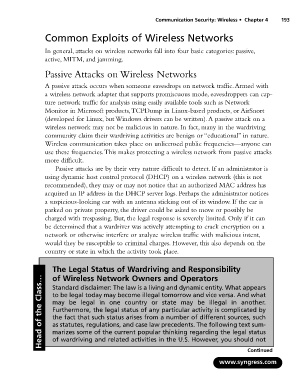Page 209 - StudyBook.pdf
P. 209
Communication Security: Wireless • Chapter 4 193
Common Exploits of Wireless Networks
In general, attacks on wireless networks fall into four basic categories: passive,
active, MITM, and jamming.
Passive Attacks on Wireless Networks
A passive attack occurs when someone eavesdrops on network traffic.Armed with
a wireless network adapter that supports promiscuous mode, eavesdroppers can cap-
ture network traffic for analysis using easily available tools such as Network
Monitor in Microsoft products,TCPDump in Linux-based products, or AirSnort
(developed for Linux, but Windows drivers can be written).A passive attack on a
wireless network may not be malicious in nature. In fact, many in the wardriving
community claim their wardriving activities are benign or “educational” in nature.
Wireless communication takes place on unlicensed public frequencies—anyone can
use these frequencies.This makes protecting a wireless network from passive attacks
more difficult.
Passive attacks are by their very nature difficult to detect. If an administrator is
using dynamic host control protocol (DHCP) on a wireless network (this is not
recommended), they may or may not notice that an authorized MAC address has
acquired an IP address in the DHCP server logs. Perhaps the administrator notices
a suspicious-looking car with an antenna sticking out of its window. If the car is
parked on private property, the driver could be asked to move or possibly be
charged with trespassing. But, the legal response is severely limited. Only if it can
be determined that a wardriver was actively attempting to crack encryption on a
network or otherwise interfere or analyze wireless traffic with malicious intent,
would they be susceptible to criminal charges. However, this also depends on the
country or state in which the activity took place.
The Legal Status of Wardriving and Responsibility
Head of the Class… to be legal today may become illegal tomorrow and vice versa. And what
of Wireless Network Owners and Operators
Standard disclaimer: The law is a living and dynamic entity. What appears
may be legal in one country or state may be illegal in another.
Furthermore, the legal status of any particular activity is complicated by
the fact that such status arises from a number of different sources, such
as statutes, regulations, and case law precedents. The following text sum-
marizes some of the current popular thinking regarding the legal status
of wardriving and related activities in the U.S. However, you should not
Continued
www.syngress.com

